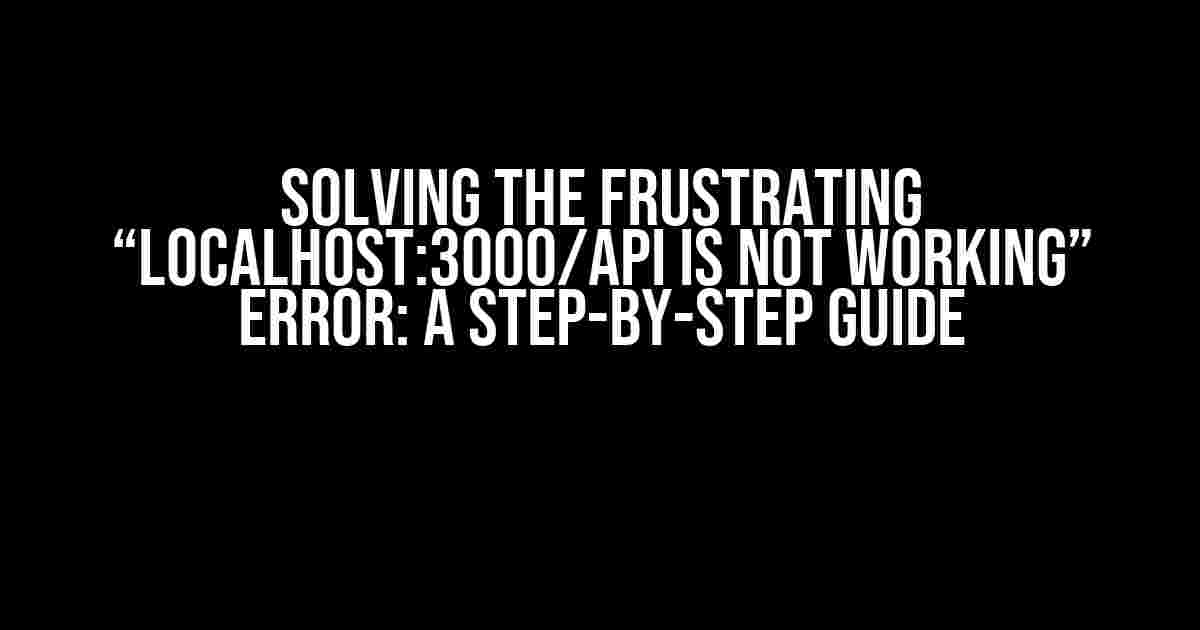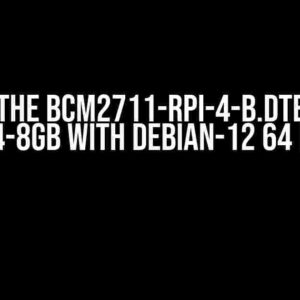Are you tired of seeing the dreaded “This page isn’t working” error when trying to access your localhost:3000/api? You’re not alone! This frustrating issue can bring your development process to a grinding halt. But fear not, dear developer, for we’re about to embark on a journey to diagnose and fix this pesky problem once and for all.
What’s Causing the Error?
Before we dive into the solutions, it’s essential to understand the possible causes of this error. Here are some common culprits:
- Incorrect Server Configuration: A misconfigured server or incorrect settings can prevent your API from responding.
- Port Conflict: Another process or application might be occupying port 3000, causing a conflict.
- Network Connectivity Issues: Problems with your network connection or firewall can block access to your API.
- Code Errors or Bugs: Syntax errors, typos, or logical mistakes in your code can prevent your API from functioning correctly.
- Dependency Issues: Incompatible or outdated dependencies can cause conflicts and errors.
Step 1: Check Server Configuration
Let’s start by verifying your server configuration. Check your server file (e.g., server.js, app.js, or index.js) and ensure that:
- The server is listening on the correct port (3000 in this case).
- The API endpoint is correctly defined and routed.
- Any necessary middleware or dependencies are properly imported and initialized.
const express = require('express');
const app = express();
app.use(express.json());
app.use(express.urlencoded({ extended: true }));
app.listen(3000, () => {
console.log('Server listening on port 3000');
});
Verify Port Availability
Next, let’s ensure that port 3000 is not occupied by another process:
$ netstat -tlnp | grep 3000
This command checks for any process listening on port 3000. If you find another process occupying the port, you can:
- Kill the process using the PID (Process ID) displayed in the output.
- Change the port number in your server configuration to an available one.
Step 2: Investigate Network Connectivity
Now, let’s rule out any network connectivity issues:
- Check your internet connection and ensure it’s stable.
- Verify that your firewall or antivirus software isn’t blocking the connection.
- Try accessing your API from a different device or network to isolate the issue.
Firewall Configuration
If you’re using a firewall, ensure that:
- Inbound traffic on port 3000 is allowed.
- Outbound traffic from your server to the API endpoint is permitted.
| Firewall | Configuration Steps |
|---|---|
| Windows Defender Firewall |
|
| ufw (Ubuntu, Linux) |
|
Step 3: Code Review and Debugging
It’s time to scrutinize your code and debug any potential issues:
- Check for syntax errors using a linter or IDE.
- Verify that your API endpoint is correctly defined and routed.
- Use console.log() or a debugger to inspect variables and code execution.
- Test individual components or functions to isolate the issue.
Dependency Issues
If you’re using third-party dependencies, ensure they’re up-to-date and compatible:
- Check the version compatibility of your dependencies.
- Run
npm outdatedoryarn outdatedto identify outdated dependencies. - Update dependencies using
npm installoryarn install.
Step 4: API Endpoint Verification
Let’s verify that your API endpoint is correctly configured and responding:
- Use a tool like Postman, cURL, or a browser extension to send requests to your API endpoint.
- Check the response status code and body for errors or unexpected behavior.
- Verify that your API endpoint is correctly defined and routed in your server configuration.
Bonus Tips and Troubleshooting
Here are some additional tips to help you troubleshoot the “localhost:3000/api is not working” error:
- Check your browser console for any errors or warnings.
- Use the Network tab in your browser’s DevTools to inspect request and response headers.
- Try accessing your API endpoint from a different browser or device to isolate the issue.
- Consult the official documentation for your framework, library, or dependency for specific troubleshooting guides.
Conclusion
By following these steps and troubleshooting guides, you should be able to identify and resolve the “localhost:3000/api is not working” error. Remember to stay calm, methodically work through each step, and don’t hesitate to ask for help when needed. Happy debugging!
Now, go forth and conquer that error!
Frequently Asked Question
Don’t let “This page isn’t working” errors get in the way of your productivity! Check out our top 5 FAQs to troubleshoot localhost:3000/api issues and get back to coding in no time.
Q1: What is the most common reason for localhost:3000/api not working?
A1: The most common reason is that the development server is not running. Make sure you’ve started the server by running the command `npm start` or `yarn start` in your terminal, and try accessing localhost:3000/api again.
Q2: Could my firewall or antivirus be blocking the connection?
A2: Yes, it’s possible! Firewalls and antivirus software can sometimes block connections to localhost. Try temporarily disabling them or adding an exception for localhost:3000 to see if that resolves the issue.
Q3: Are there any Chrome extensions that could be interfering with localhost:3000/api?
A3: Yes, some Chrome extensions like AdBlock or tracking blockers might interfere with localhost:3000/api. Try disabling them one by one to see if the issue resolves.
Q4: Could my code be causing the issue?
A4: It’s possible! Check your code for any syntax errors, typos, or incorrect API routes. If you’re still stuck, try debugging your code or seeking help from a coding community.
Q5: Should I try resetting my browser or computer?
A5: If all else fails, try resetting your browser or even rebooting your computer. Sometimes, a fresh start can work wonders!


